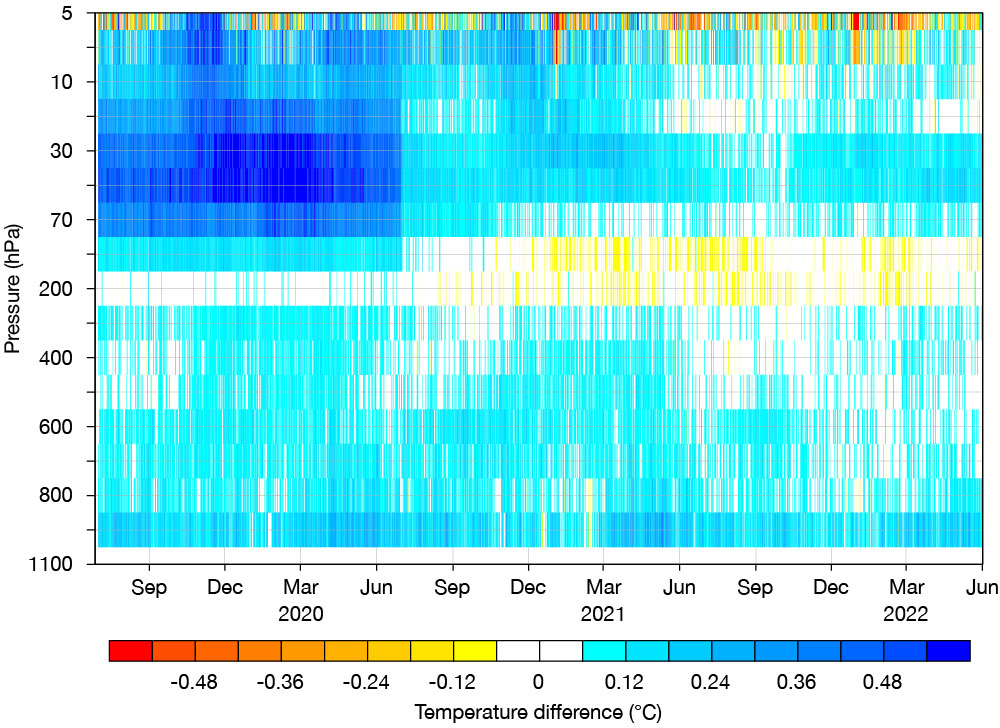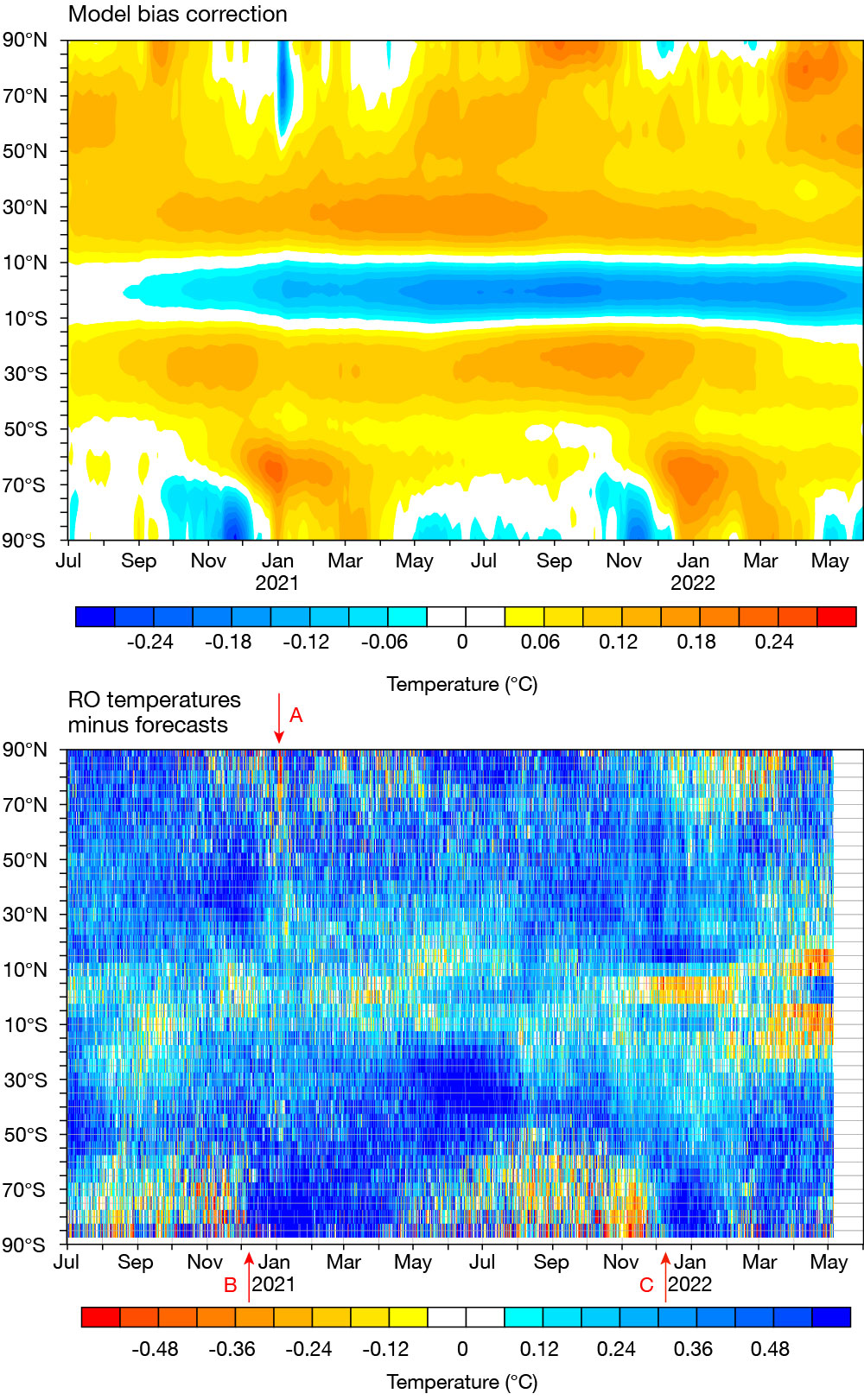There has been a renewed impetus in recent years to understand and improve the performance of ECMWF’s Integrated Forecasting System (IFS) in the stratosphere. On 30 June 2020, ECMWF implemented a substantial upgrade with Cycle 47r1. In the atmospheric model, the advection of temperature and humidity was changed by increasing the order of the vertical interpolation in the semi-Lagrangian scheme from three to five (ECMWF Newsletter 163). In data assimilation, a modification of the standard 4D‑Var algorithm, called weak-constraint 4D‑Var, was implemented to correct for stratospheric residual biases when the model is used in the data assimilation system (ECMWF Newsletter 163). These two developments reduce forecast biases considerably and improve the quality of the analysis used to initialise operational forecasts. Here we look back at the last two years of operational data since the implementation of Cycle 47r1 to discuss how these developments performed over different seasons as well as during some specific weather events.
Reduced overall bias
Atmospheric in-situ observations from radiosondes are important both for direct use in the ECMWF data assimilation system and for monitoring the quality of the model. It was found many years ago that the IFS suffers from a number of stratospheric temperature biases. In particular, the lower to mid-stratosphere is biased cold and the uppermost stratosphere is biased warm. The cooling that occurs is partly due to discretisation errors in the vertical advection associated with an inadequate representation of resolved gravity waves in the vertical direction. This can be seen in the first figure before 30 June 2020, where the difference between radiosonde temperature observations and model first-guess trajectories (our best estimate of the state of the atmosphere prior to the use of new observations) is larger than 0.5 K at around 50 hPa. The implementation of weak-constraint 4D‑Var and quintic interpolation in Cycle 47r1 has alleviated this issue and the model first-guess trajectory is now much less biased.

The role of radio occultation measurements
For each assimilation cycle, weak-constraint 4D‑Var estimates a temperature forcing term into the model to correct for the model bias which builds up in the model trajectory. The top panel of the second figure shows a time series over the past two years of model bias correction for pressure levels between 20 hPa and 30 hPa. To improve the verification of forecasts in the stratosphere, a tool has been developed to compare the model against temperature retrievals from radio occultation (RO). These highly accurate retrievals have a good vertical resolution with a globally homogeneous distribution of around 3,000 profiles per day, which makes it possible to study the structure of the model bias that develops during an uncorrected model integration. The bottom panel of the second figure shows this diagnostic after 12 hours between 20 hPa and 30 hPa. The result shows model bias that closely corresponds to the weak-constraint 4D‑Var correction. It is important to note that, although quintic interpolation is active in the forecasting model, the weak-constraint 4D‑Var correction is only estimated and applied in the data assimilation system and not during the forecast.
The RO diagnostic illustrates the overall cold bias in 12‑hour forecasts of the mid-stratosphere. Weak-constraint 4D‑Var detects a large fraction of this bias and corrects the model used in 4D‑Var accordingly. This correction enables an improved assimilation of observations and the production of a more accurate analysis.

Three examples
On 31 December 2020, a Sudden Stratospheric Warming (SSW) event started over the northern hemisphere. These events usually generate a large warm model bias in the mid-stratosphere over a number of days (arrow A), although the physical processes behind this bias are not yet fully understood. Weak-constraint 4D‑Var was able to detect this abrupt change and cooled down the model bias adequately.
There is a clear seasonal cycle in the model bias over the southern hemisphere with a sharp transition in early December 2020 (arrow B) and 2021 (arrow C). The warm bias in the southern polar stratosphere from May to November and the cold bias in other seasons is a robust feature in the IFS on all forecast timescales. The origin of this warm bias is not yet fully understood but could be related to parametrized gravity wave drag being too strong during this season. Once again, weak-constraint 4D‑Var learnt that seasonal structure appropriately from all the observations sensitive to stratospheric temperature that are assimilated. In the northern hemisphere, which is much more variable from year to year due to stronger planetary wave activity, such seasonality in the polar bias can also be seen but is weaker and is not clearly present every year.
Conclusion
Accessing high-quality observations, such as radio occultation measurements, is critical for numerical weather prediction. On the one hand, they are used in the data assimilation system to estimate the best initial conditions possible. On the other, they can be used to diagnose model deficiencies and help to drive future model developments. They show that, over the last two years, weak-constraint 4D‑Var has helped to produce more accurate initial conditions for temperature in the stratosphere.
